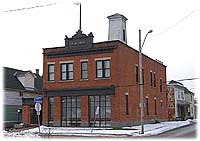Fire Station No. 3
239 Champlain Street

City fires have always been devastating, because they affect a large number of people. In 1808, on the north shore of the Chaudière Falls, the first major fire burned down the mills, tanneries and other industrial installations built since 1803 by Philemon Wright and his sons. But the most devastating fires occurred between 1880 and 1906. Raymond Ouimet, a Hull history buff, published Une ville en flame (A City in Flames), eloquently describing the events surrounding the major fires in Hull.
Until 1869, the people of Hull relied on Ottawa's fire engines. After a fire burned down 12 houses in its territory, the municipality of Hull purchased its own fire engine, named "Victoria", and recruited two volunteer fire brigades. These measures, however, were barely adequate for handling even small fires. In 1886, an attempt was made to solve the problem by building an aqueduct - which now houses a theatre, the Théâtre de l'Île - but the pipes were too narrow. The City hired firemen and supplied them with the latest equipment, but they were powerless against the 1888 fire in the Laurier district.
The first fire station was built on Leduc Street in 1889. This station, like the E. B. Eddy fire engines, could do nothing to contain the most devastating of the fires (April 26, 1900), which spread from Hull to Ottawa. Fortunately, despite the fact that nearly 3,200 buildings burned down, only six people were killed in the Great Fire. It was followed by other major fires, but it was ten years before alderman Joseph Gravelle finally managed to convince the Council to buy a new steam fire engine, which was named "Colonel J.-E. Gravelle". Finally, the City Council passed a bylaw in 1911, the Règlement municipal relatif aux incendies et au service des incendies (Municipal bylaw concerning fires and the fire service), and a second bylaw issuing debentures in the amount of $42,000 for the construction of two fire stations and the purchase of equipment.
The first two fire stations were in the Val Tétreau and Laurier districts. On September 6, 1911, the Council voted for the purchase of a lot on the corner of Champlain and St-Étienne Streets, belonging to the heirs of Nancy Louisa Wright, and a wooden house of two-and-a-half storeys and its outbuildings, property of the labourer Samuel Albert. The construction of Fire Station 3 began there in the fall of 1911 and continued through the winter of 1912, at the same time as work on Station 2. The architecture and construction of both buildings were entrusted to the Hull architect Charles Brodeur and the contractor Arthur Bourque, son of Joseph Bourque.
Stations 2 and 3 had the same equipment. Joseph Dufour supplied engines with fire hoses ($585 each), sleds ($200 each), two summer vehicles and two winter vehicles for the chiefs ($75 each), and two simple fire engines ($180). Two ladder trucks, with hooks and ladders, were purchased from the Ottawa Car Co. On April 1, 1912, the Council agreed on the purchase of the horses, furniture and equipment required by the two new stations. On May 6, the Comité de police, feu et lumière (Police, Fire and Lighting Committee) recommended that four new men be hired for the engines of Station 3, which opened its doors that same day.
When the fire service was centralized in a new station on the corner of Leduc and Garneau, the City of Hull sold Station 3 to Louis Beaumont, on March 9, 1963. On August 7 of that year, the building was purchased by Alberto Cuhna, a priest from the Portuguese community, who tried to establish a centre for young people. Plays were mounted there, at least in summer, and the building became a community centre. A snowshoers' club, Les Amis choisis, held its meetings there. Cuhna held onto the building for several years, although he was often on the verge of losing it. He finally ceded it to the Caisse populaire de Hull (Hull Credit Union) in 1976. In October 1978, it was purchased in trust by Glen Gray, who converted the building into offices before reselling it in 1987. Since then, the former fire station has been privately owned.
|